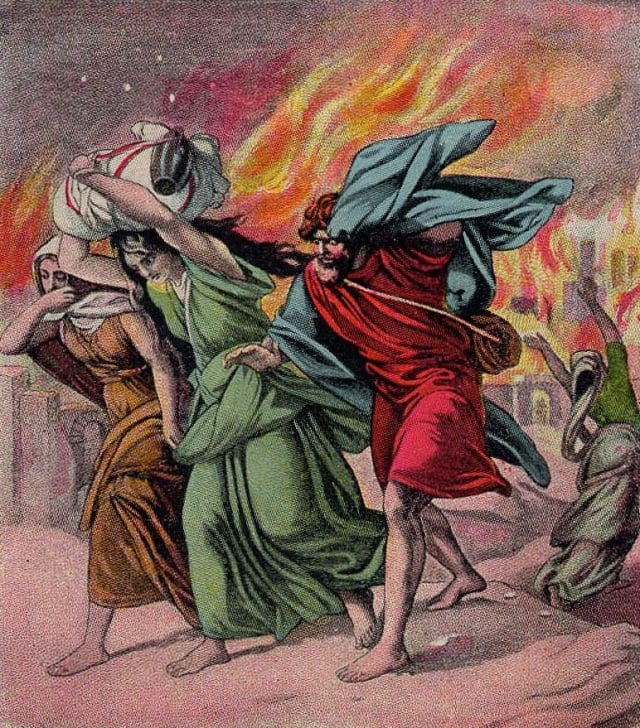
Lot showed some angels hospitality, so they tipped him off before destroying his city
In ancient myths it’s usually wise to help those in need. If wanderers come knocking at your door asking for shelter, they’re probably gods, or angels, or saints in disguise. Help them out and you might be blessed, or at least spared from a large-scale purge (depending on how cuddly your deity is). Take the time to twiddle the thorn out of that lion’s paw instead of killing the beast, and it might save your life later when you’re matched against each other in gladiatorial combat — what luck! It doesn’t matter as much if many people are ungrateful or untrustworthy. If you make a policy of providing help where it’s needed, the karmic mechanics of a mythological universe are such that you will get your come-uppance.
In the modern world, things are rarely so tidy. If you see a vagrant on the street, bind his wounds and put him up in an inn and put his room service on your tab — as the Good Samaritan did — Jesus might call you “neighbor” but it’s unlikely you’ll be so overtly rewarded, at least in this world. When we act charitably, it is despite the absence of a material payoff, and the fact that there’s never anybody watching us.
Well, almost never.
The Watchful Eye of Science
Enter social psychologists John Darley and Daniel Batson. The year is 1970. Batson will eventually go on to develop the empathy-altruism hypothesis of social psychology — empathizing with a person in need motivates you to help them altruistically. This doesn’t sound like a big deal until you realize that a lot of psychologists don’t think human altruism actually exists. In 1970, he is doing graduate work in psychology under Professor Darley at Princeton University. Darley at the time is famous for helping discover, in an experimental context, the bystander effect — the larger the group of people who can help, the less likely any individual is to actually help.
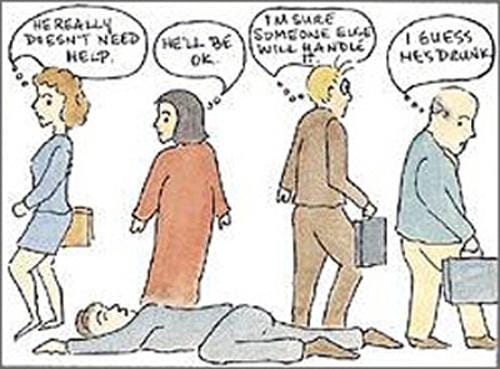
An illustration of the bystander effect
Darley’s research was inspired by the murder of Kitty Genovese in 1964, which for many years was held up as the bystander archetype: a woman raped and murdered outside a New York apartment building while 38 people bore silent witness from the comfort of their homes. Recent reporting has revealed that this story was inaccurate in many ways. Many people tried to help — shouted at the attacker, called the police, ran out and held Genovese as she died. And no one person witnessed the crime in its entirety or knew how serious it was until it was over. But Darley and his colleagues’ science remains sound through this controversy. In 2007, one of the main papers critiquing the incident’s impact on science acknowledged that the bystander effect was among “the most robust phenomena in social psychology.”
Together, Darley and Batson designed a study of Princeton seminary students. The students were surveyed about their personalities and attitudes towards religion, then asked to prepare a presentation on a biblical subject, and to give that presentation in a room in another building. Little did they know that the scientists weren’t actually going to evaluate the subjects’ performances. Darley and Batson were really interested in how students treated the “shabbily-dressed” actor sitting slumped in an alleyway between the buildings.
“When the subject passed through the alley, the victim was sitting slumped in a door-way, head down, eyes closed, not moving. As the subject went by, the victim coughed twice and groaned, keeping his head down. If the subject stopped and asked if something was wrong or offered to help, the victim, startled and somewhat groggy, said, “Oh, thank you [cough]. . . . No, it’s all right. [Pause] I’ve got this respiratory condition [cough]. . . . The doctor’s given me these pills to take, and I just took one. . . . If I just sit and rest for a few minutes I’ll be O.K. . . . Thanks very much for stopping though [smiles weakly].” If the subject persisted, insisting on taking the victim inside the building, the victim allowed him to do so and thanked him.”
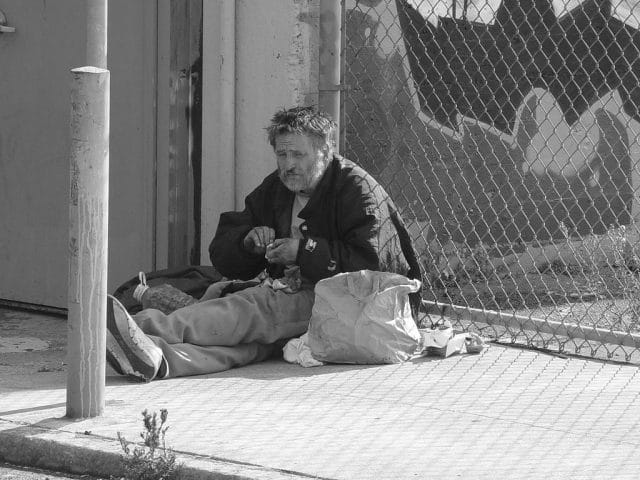
A homeless person slumped on a San Francisco sidewalk — Franco Folini
They interviewed the actor and the subject afterwards to figure out how much each subject helped on a scale of 0 to 5. 0s didn’t notice the victim at all. 1s noticed but didn’t help. 2s noticed and helped indirectly, like by telling one of the experiment proctors about the victim. 3s stopped and talked to the victim. 4s brought him inside. 5s insisted on taking the victim somewhere ‘outside the experimental context,’ like to the hospital, or out for coffee, (if that last one sounds implausible for anybody, especially anybody in the midst of an academic study, remember that these subjects were aspiring young priests).
40% of the subjects, overall, helped at all (scored a 2 or higher) — i.e. 60% of them did not help at all.
Some subjects were told they were very late and should hurry, others were told that time was of the essence, and still others were told they were early. Only 10% of those in the first “high hurry” group helped at all, but 63% in the last, “low hurry” group did. This was a much larger effect than was seen by any personality variable, or by whether the presentation the subject had been asked to prepare was on the Good Samaritan parable. The big take-away: your situation often has more influence over your behavior than your character does.
A person in a hurry may stop and offer help to a person in distress. A person in a hurry is likely to keep going. Ironically, he is likely to keep going even if he is hurrying to speak on the parable of the Good Samaritan, thus inadvertenly confirming the point of the parable. (Indeed, on several occasions, a seminary student going to give his talk on the parable of the Good Samaritan literally stepped over the victim as he hurried on his way!)
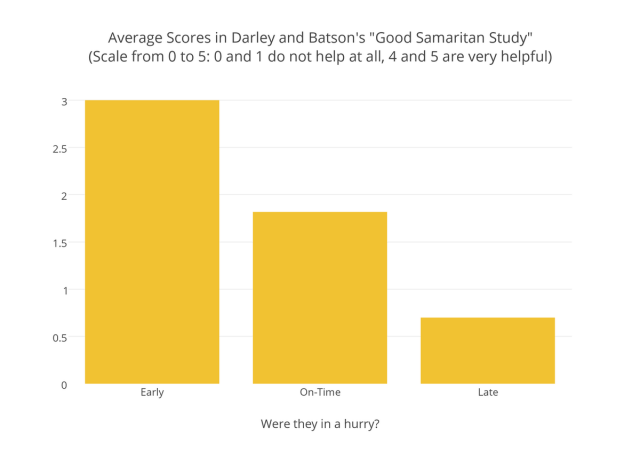
The study, published in 1973, left an imprint in the field of social psychology. Following in the tradition of the bystander effect paper it showed that there may or may not be bad people, but there are certainly bad situations — and even the more prosaic of them have a huge effect on our ethical and unethical behavior, regardless of our values or personality. In other words: the eye of science is less judgmental than the eye of the Lord, which is comforting to those of us for whom “late” and “in a hurry” are frequent states-of-being. As Darley told the New York Times:
We’re not saying that some of our seminarians are priests or Levites and others are Good Samaritans, […] but rather that common interpretations of the parable seem to emphasize personality types and our results do not.
One can imagine the priest and Levite, prominent public figures, hurrying along with little balck books full of meetings and appointments, glancing furtively at their sun dials as they go. […] In contrast, the Samaritan, a man of much lower public status, would likely have fewer and less important people counting on him to be a set place at a set time.
So if you want to be a better person, quit being such a slave to your sundial.
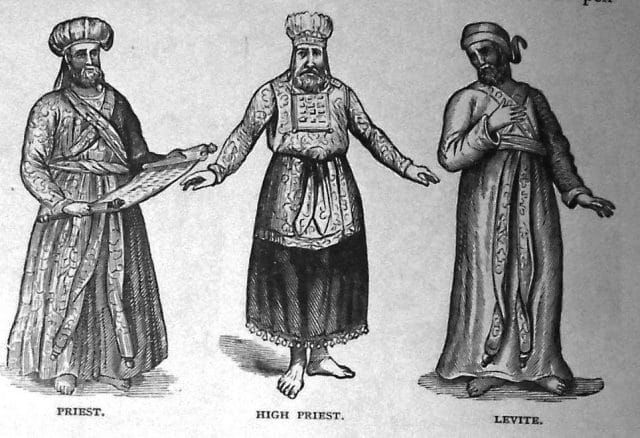
If you were wondering what a Levite was.
This post was written by Rosie Cima; you can follow her on Twitter here. To get occasional notifications when we write blog posts, please sign up for our email list



